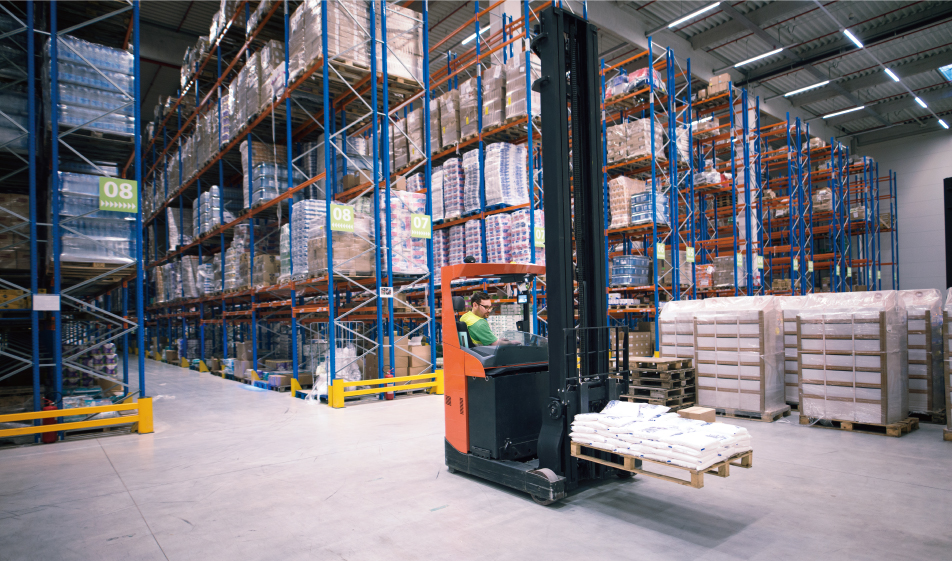How to Calculate the Appropriate Aisle Width for Warehouses

In warehouse design, calculating the appropriate aisle width is an indispensable part of warehouse planning. Whether you're working with traditional racking systems or automated storage solutions , the right aisle configuration directly impacts your facility's performance.
This article offers a comprehensive guide to help you determine the optimal aisle width for your warehouse, focusing on the most effective use of space.
Why Aisle Width Matters
Aisle width is the measurement of the open space between racks, allowing for the movement of material handling equipment (MHE) such as forklifts and pallet shuttles. The aisle width affects multiple aspects of warehouse operation, including:
- Storage capacity: Wider aisles provide more room for equipment but reduce available storage space. Narrower aisles maximize storage but require specialized equipment.
- Order fulfillment speed: Proper aisle width optimizes the flow of goods, speeding up retrieval and order picking processes.
- Safety and maneuverability: Adequate space ensures that MHE can navigate aisles safely without risking damage to products or equipment.
Key Factors in Determining Aisle Width
The width of your warehouse aisles depends on several variables:
- Forklift Equipment: Larger forklifts require wider aisles, while narrow-aisle equipment like VNA (Very Narrow Aisle) trucks can operate in smaller spaces.
- Pallet Size: The size of pallets affects space needed for maneuvering and accessing inventory.
- Racking System: Different systems, such as pallet racks and automated storage and retrieval systems (ASRS), have specific aisle space requirements.
- Forklift Turn Radius: The space required for forklifts to complete a full turn must be considered.
- Maneuverability: A minimum clearance of 12 inches is typically recommended for optimal forklift maneuverability.
- Racking Depth and Height: Deeper racking systems may require additional aisle space.
Different Aisle Width Categories
- Wide Aisles (>10') - Allow large forklifts ample space but reduce storage density.
- Narrow Aisles (9') - A balance between accessibility and storage density, ideal for most warehouses.
- Very Narrow Aisles (<9') - Used with specialized equipment such as VNA trucks or automated storage systems.
Choosing the Right Aisle Width for Your Facility
Forklift Aisle Width Requirements
| Forklift Type | Aisle Width Requirement |
|---|---|
| Counterbalanced Forklifts | 12-16 feet |
| Reach Trucks | 10-12 feet |
| Narrow Aisle (VNA) Trucks | 7-9 feet |
| Deep Reach Trucks | 10-14 feet |
| Order Pickers | 10-12 feet |
Racking System Aisle Width Requirements
- Selective Pallet Racking: 10-12 feet for reach trucks, 12-16 feet for counterbalanced forklifts.
- Pushback Pallet Racking: Typically 12-14 feet to accommodate deep lanes.
- Drive-in Racking: Requires up to 14 feet for forklifts to enter the racking structure.
- Automated Storage and Retrieval Systems (ASRS): Compact aisle widths of 6-8 feet.
How to Calculate Aisle Width for Your Warehouse
To calculate aisle width, consider forklift head length, pallet size, maneuverability space, and racking system depth.
Basic Formula:
Aisle Width = Forklift Head Length + Pallet Length + Pallet Overhang + Maneuverability Space
Example Calculation
Given:
- Forklift head length: 6 feet
- Pallet length: 4 feet
- Pallet overhang: 6 inches
- Maneuverability space: 12 inches
Aisle Width Calculation:
6 feet + 4 feet + 0.5 feet + 1 foot = 11.5 feet
Optimizing Aisle Width with Automated Solutions
Automated Storage Solution such as ASRS, shuttle systems, and autonomous mobile robots (AMRs) allow for narrower aisles while improving efficiency. These systems maximize storage capacity and retrieval speed while operating in very tight configurations.
For example, a pallet shuttle system can function in aisles as narrow as 6 feet, significantly improving space utilization.
Recommended Aisle Width for Different Racking Systems and Equipment
| Racking System | Forklift Type | Recommended Aisle Width |
|---|---|---|
| Selective Pallet Racking | Reach Truck | 10-12 feet |
| Selective Pallet Racking | Counterbalanced Forklift | 12-16 feet |
| Drive-In Pallet Racking | Reach Truck | 12-14 feet |
| Pushback Pallet Racking | Reach Truck | 12-14 feet |
| Automated Storage (ASRS) | Automated Guided Vehicle | 6-8 feet |
Conclusion
Careful planning ensures the right balance between storage space and operational efficiency. Consulting with material handling experts and forklift manufacturers will help determine the best aisle width for your warehouse needs. Just Feel Free to contact us now
Do you need more information?
Our team of experts will be happy to help you with any questions you may have.
More information